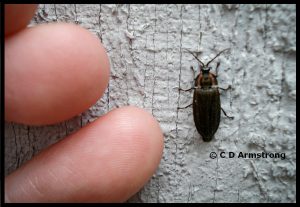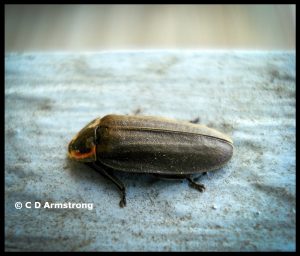Winter Firefly

The Winter Firefly (Ellychnia corrusca), is an interesting type of firefly (Family: Lampyridae) that is probably in actuality a complex of several different species, and is regarded as such. But perhaps its most interesting feature is that although it’s a firefly–and although as eggs, larvae, and pupae, they have the ability to glow–the adults cannot ‘glow’ or light up (i.e. they cannot ‘bioluminesce’) except at the very start of their adulthood, when they are able to glow weakly for a few hours but then never again! They have a lifespan of two years and overwinter as adults. They are one of the first insects to appear each spring, becoming active as early as late February. The bulk of their mating, however, takes place in April and May under warmer conditions. A second wave of adults emerges from their pupae generally in September, and soon after begin searching for protected places to spend the winter. They like to overwinter at the base of trees, or in the cracks of tree bark or underneath loose bark. Cracks on the sides of homes and other man-made structures are also fair game.

Winter firefly larvae are thought to be predators and are rarely encountered as they are typically found in leaf litter or inside decaying logs (especially pine). In areas that have pines, winter fireflies can consequently be very common and locally abundant, essentially living together as colonies. You’ll also find them on the sunny side of oaks and other hardwoods, however, and since they like to gather around the freeze cracks and other wounds found on trees, they can be a nuisance to maple syrup producers who will find them floating in their sap buckets in the spring (another common name for these firefly beetles is in fact the Sap Bucket Beetle).
Additional Information and Photos:
- Winter Firefly (BugGuide.net)
- Fireflies in Winter? (Maine Audubon)
